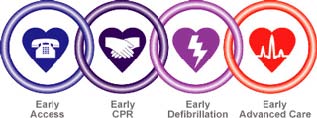Cardiopulmonary Resuscitation
LESSON 2: HEART ATTACK AND CARDIOPULMONARY RESUSCITATION
2-8
2-8. ROLE OF THE RESCUER
In order to properly treat a casualty requiring CPR, the rescuer must take the following actions. These actions are summarized in figure 2-2.
a. Early Access. The rescuer, whether trained or untrained, must activate the emergency medical service (EMS) system early, even before beginning CPR.
b. Early CARDIOPULMONARY RESUSCITATION. The brain and other body tissues cannot tolerate long term hypoxia (low state of oxygen in the blood). Because of this, CPR must be started as soon as possible to increase the chance of patient survival. High-quality bystander CPR can double or triple survival rates from cardiac arrest. Less than one-third of victims of sudden cardiac arrest (SCA) receive bystander CPR, and even fewer receive “high-quality” CPR.
c. Early Defibrillation. Treatment of ventricular fibrillation (VF) in SCA requires early CPR and shock delivery with a defibrillator. Lay rescuer and first responder CPR and automated external defibrilator (AED) programs in airports and casinos and with police officers have reported survival rates from witnessed VF SCA as high as 49 to 74 percent.
d. Early Advanced Care. Early Advanced Cardiac Life Support (ACLS) procedures should be performed.
Figure 2-2. The CPR Chain of survival (adult).


